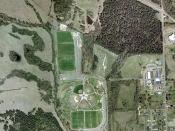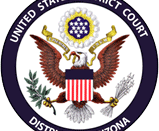University of PhoenixBusiness LawIn this Memo we will identify and analyze our client's legal situation and assess the situation and describe how the law firm can help. First, we need to answer the question what is an easement. An easement "is a given or required right to use another person's land without owning or leasing it. Easements may be either express or implied. Express easements must be in writing to be enforceable, whereas implied easements need not be written. (Cheeseman Pg.227)". The easement is for a city utility line on the property. So this means a property owner of a piece of property around the property in question has the right to run a city utility line on the property.
The court that can review and resolve the situationIn this case, the case will be reviewed and resolved in federal court because the federal court has jurisdiction in this case.
The United States district court would the federal court that would hear and resolved this case. "The United States district courts are the federal court system's trial courts of general jurisdiction. There is at least one federal district court in each state and the District of Columbia, although heavily populated states have more than one district court (Cheeseman Pg. 20)".
The court that may have jurisdiction over the situationThe United States district court would be the court that has jurisdiction over this situation. The United States district courts are the trial courts of the federal court system. The district courts have jurisdiction to hear nearly all categories of federal cases, including both civil and criminal matters.
The jurisdiction that we believe applies in this case because, "Type of Jurisdiction Description1.Federal question Cases arising under the U.S. Constitution, treaties, and federal statutes and regulations. There is no dollar-amount limit in federal question cases.
2.Diversity of citizenship Cases between (i) citizens of different states, (ii) a citizen of a state and a citizen or subject of a foreign country, and (iii) a citizen of a state and a foreign country where a foreign country is the plaintiff. Federal courts must apply the appropriate state law in such cases. The controversy must exceed $75,000 for the federal court to hear the case. (Cheeseman Pg. 24)"Therefore, in this case which involves both civil and criminal charges The United States district court would be able to hear and resolve both issues. The civil cases involve the lawsuit brought by the City against Mr. Jones for fraud against a municipality. In addition, the adjacent property owner the citizen of Switzerland is sewing for damages to his property. The criminal charges in this case involve the charges fraud and trespassing. All of these issues in this situation can be resolved in The United States district court.
Process Civil Court and Criminal CourtSteps need to be taken by the plaintiffs when a lawsuit is filed. In a civil court procedure papers must be file correctly by lawyers. Process can take time and can be stressful. The initial steps include, initial paper or document must be file, fact-finding and discovery, court motion, alternative dispute resolution, trial and verdict, judgment and appeal.
Initial court paper must be file by the plaintiff in a form of complaint or petition. Then documents will provide an outline of the case against the defendant. The complaint document must include the name of the defendant or parties involved. The complaint should also include a demand judgment or a relief against the defendant. The plaintiff should seek out from the judge on how the payment should be pay if the plaintiff should win the case. After the initial document is filed the court issues a summons to notify the defendant of the suite and where it will be litigated. The defendant will be given sometime to answer the question or a request to dismiss the case if the complaint by the plaintiff is false. But if the defendant fail to show up for a certain day and time then it become default and the defendant lose. Another step or procedure to civil court is discovery. Discovery is presented so there would be no surprises. All relevant facts and document must be summated to the defendant before it goes to trial. There are three layers to discovery, written discovery, document production and deposition. Written discovery are question and answer that is being ask, it could be now in the present or it could be question about the past that happen years ago. Document production anything that is related to the case such as medical records, defect case and or computer file. Deposition is a sworn statement that can range form week to month, and years back.
Before a trial is set to be heard, a lawyer can ask for a motion to dismiss the case if there is not enough evidence or the complain is not relevant to the case. The court will look into to see if there is a lack of subject matter jurisdiction or a lack of personal jurisdiction. Another step in a civil court procedure is in a form of alternative dispute resolution. Both sides have a chance to settle the dispute through arbitration before it goes to trial. If the case does go to trial a judge or jury will decide by preponderance of evidence if the plaintiff is to win.
On the other hand in a criminal case, there must be intent to comment a crime in order to press charge against a person. The case between the city, the property owner, and Mr. Jones's business regarding the right of utility easement. If Mr. Jones knows that he dose not has the right of easement and still run utility through the neighbor property, then a criminal charge maybe file against him by the city and by the adjacent property owner.
Inclusion when a bringing a lawsuits against a person or business. Steps have to be taken and document must be file correctly by the plaintiff. In the civil court there are steps to be taken. It includes initial court paper, fact-finding and discovery, court motion, alternative dispute resolution, trial and verdict, judgment, and appeals. On the other hand criminal case there must be intent to do harm to other before a lawsuit can be file.
Internal Memo for ClientThe following information is listed as several options for Mr. Al Jones and his land development company. Mr. Jones can repair all damages to the adjacent property owner's property and remove any present easement that has been put onto this property and or pay for any damages within reason. Mr. Jones can purchase said property from the adjacent land owner if possible. In doing so, this would eliminate the cities issues about the easement. Mr. Jones can request from the City a variance for this project under the existence of the easement based on the circumstances of this case. Each case is looked at based on its own merits and decided upon as such. The firm suggests that the land owner, Mr. Al Jones, begin in good faith, alternate dispute resolution (ADR) talks with the City and the adjacent property owner to resolve the issue at hand involving the utility easement in question.
ArbitrationBased on this idea, alternative dispute resolution refers to several options including arbitration, mediation and conciliation. Within the boundaries of arbitration both parties will hire an uninterested third party (i.e., the arbitrator) to hear and decide the dispute. This person will meet with each party in the case and relay information back and forth stating the other parties concerns, trying to come to some kind of compromise. Once this is done it can become a binding agreement. This is the most commonly used form of alternative dispute resolution according to an article in Business Credit. Alternative dispute resolution has experienced steadily increasing acceptance and utilization because of a perception of greater flexibility, costs below those of traditional litigation and speedy resolution of disputes (Business Credit, 2006).
MediationMediation also involves the use of an uninterested third party (i.e., the mediator) to act as a go between to settle discussions. The mediator directs the dialogue in a way that helps each parties needs and everyone's viewpoint is taken into account and reaffirms performance of the parties.
Unlike an arbitrator, a mediator does not decide the issue, but guides the negotiations and helps the parties reach their own agreement. In a typical mediation, the parties personally participate in joint sessions and in private caucuses that the mediator holds with each party and its attorney. Because mediation is non-binding, both parties retain the right to pursue other means of resolving the dispute. Because of the informal, confidential and non-binding nature of mediation, the management representative often plays a greater role in reaching a business solution than in more structured legal processes, such as arbitration or litigation, where legal counsel is much more in control of the process and direction of the proceeding (Autry, Reid, & Hall, 2005).
ConciliationConciliation is the process in which the parties to an issue agree to use the services of a conciliator, an interested party, who will then meet with all interested groups that have a vested interest separately in an attempt to resolve their differences. Conciliation is different from arbitration in that the conciliation process has no legal binding or standing. The conciliator normally will not write any resolutions or make any judgments on the issue. Conciliation is similar to mediation, but differs in that the main goal is to find common ground to make concessions. With conciliation, the disputing parties seldom have face to face contact across the table for discussion. If the conciliator can successfully negotiate an arrangement between all parties, the settlement is put in writing and signed by the parties, at which time it becomes a legal contract.
ConclusionIn closing, it is this firm's belief that Mr. Jones would be best suited to choose some form of alternative dispute resolution to resolve this matter with the City and the adjacent land owner. We as your attorney would advise you to settle the case with an agreement to allow the land owner with the easement to keep his easement; after all we are only talking about an easement for a city utility line. It is out belief that with development going on the property the line could easily be rerouted with minimal interruption to the adjacent land owner.
ReferencesAutry, C. T., Reid, G. C., & Hall, R. F. (2005, Fall). Mediation: Effective Resolution of Contract Disputes. Management Quarterly, 46(3), p10-25.
Business Credit (2006, April). Dispute Resolution. Business Credit, 108(4), p62.
The Legal Environment of Business and Online Commerce: Business Ethics, E Commerce, Regulatory, and International Issues, Fifth Edition, by Henry R. Cheeseman. Published by Prentice Hall.Copyright é 2007 by Pearson Education, Inc. Retrieved May 11, 2008, from UOP library.
United States District CourtsRetrieved from http://www.uscourts.gov/districtcourts.html on May 11, 2008

![Rosalie Jones' Army [Suffragettes] (LOC)](https://s.writework.com/uploads/17/172375/rosalie-jones-army-suffragettes-loc-thumb.jpg)



